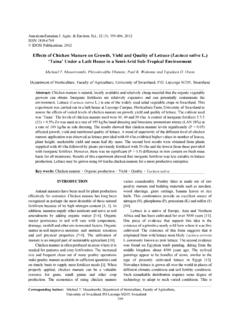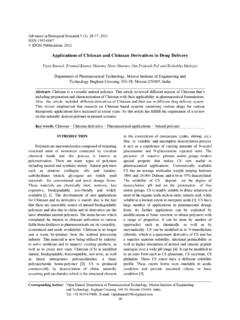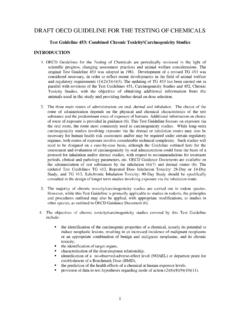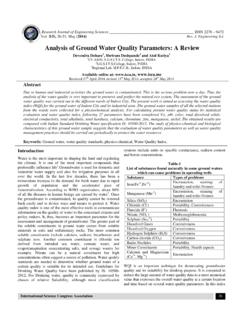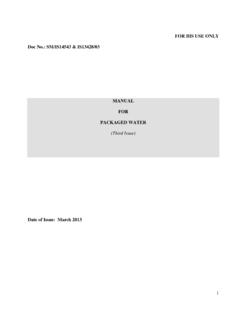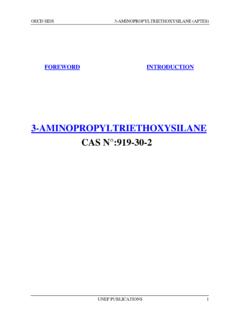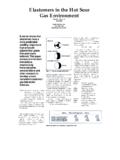Transcription of The Separation Method for Removing of Colloidal …
1 American-Eurasian J. Agric. & Environ. Sci., 4 (2): 266-273, 2008. ISSN 1818-6769. IDOSI Publications, 2008. The Separation Method for Removing of Colloidal Particles from Raw water A. Koohestanian, M. Hosseini and Z. Abbasian Faculty of chemical Engineering, Babol Noshirvani University Abstract: The objective of this study was to develop a treatment system that can effectively reduce the concentration of Colloidal particles in raw water that can greatly reduce the cost of treatment and improve the subsequent steps of treatment. Aluminum sulphate (alum) and ferric chloride as a coagulant and anionic polymer as coagulant aid were used in the process that changed the scale of particles from nanoscale to microscale and larger by a physico- chemical process.
2 The influence of PH, temperature, coagulant and coagulant aid dosages on the coagulation process was studied and conditions were optimized corresponding to the best removal of organic matters, viruses, colloids, bacteria, color and decrease in turbidity. 85-98% reduction of turbidity from raw water can be achieved by using the optimum coagulant dosage (8ppm, ferric chloride/10 ppm, alum) in the optimum PH range ( , ferric , alum) in the optimum temperature (20 C, ferric chloride/24 C, alum). Ferric chloride produced better results than alum. Higher dosages did not significantly increase pollutant removal and were not economical. The results provide useful information for raw water treatment. Key words: Colloidal particles Clarification Coagulation Flocculation water treatment.
3 Typical diameter in metres INTRODUCTION. 1E-10 1E-08 1E-06 1E-04 1E-02. Solids are present in water in three main forms: 1 nm 1 um 1 mm suspended particles, colloids and dissolved molecules. Molecules Suspended particles, such as sand, vegetable matter Colloids and silts, range in size from very large particles down to Suspended particles particles with a typical dimension of 10 m. Colloids are very fine particles, typically ranging from 10 nm to Pathogenic Viruses protozoa 10 m. Dissolved molecules are present as individual molecules or as ions. Figure 1 illustrates the size ranges Bacteria of solids in water . Algae In general, suspended particles are simply removed by conventional physical treatment like sedimentation and filtration.
4 Dissolved molecules cannot be removed Fig. 1: Size range of particles of concern in water by conventional physical treatment. Thus, the removal treatment of colloids is the main objective and the most difficult aspect in conventional water treatment. carry negative electrostatic charges. Since the particles There are two types of colloids: hydrophilic have similar negative electrical charges and electrical colloids and hydrophobic colloids. Hydrophobic forces to keep the individual particles separate, the colloids, including clay and non-hydrated metal oxides, colloids stay in suspension as small particles. are unstable. The colloids are easily destabilized. The magnitude of the zeta potential (Zp) is usually Hydrophilic colloids like soap are stable.
5 When these used to indicate Colloidal particle stability. The higher colloids are mixed with water , they form Colloidal the zeta potential, the greater are the repulsion forces solutions that are not easily destabilized. Most between the Colloidal particles and, therefore, the more suspended solids smaller than mm found in waters stable is the Colloidal suspension. A high Zp represents Corresponding Author: M. Hosseini, Faculty of chemical Engineering, Babol Noshirvani University 266. Am-Euras. J. Agric. & Environ. Sci., 4 (2): 266-273, 2008. strong forces of Separation (via electrostatic repulsion). and a stable system, particles tend to suspend. Low Zp indicates relatively unstable systems, particles tend to aggregate.
6 To remove colloids, small particles have to be destabilized first and then they will form larger and heavier flocks which can be removed by conventional physical treatment. This process can be described by clarification mechanisms, that includes: coagulation, Fig. 2: Bridging flocculation flocculation and sedimentation. The chart below shows the length of time that is required for particles of different sizes to settle through the water . Coagulation is the process of decreasing or neutralizing the negative charge on suspended particles or zeta potential. This allows the van der Waals force of attraction to encourage initial aggregation of Colloidal and fine suspended materials to form microflock. Rapid, high energy mixing is necessary to ensure the coagulant is fully mixed into the process flow to maximize its effectiveness.
7 The coagulation process occurs very Fig. 3: Coagulation, flocculation and sedimentation quickly, in a matter of fractions of a second. process Flocculation is the process of bringing together the particles to form large agglomerations by physically mixing or through the bridging action of coagulant aids, such as long chainpolymer. Destabilization by bridging occurs when a polymer of a high molecular weight becomes attached at a number of adsorption sites to the surface of negatively charged particles along the polymer chain. The remainder of the polymer may remain extended into the solution and may adsorb on available surface sites of Fig. 4: The three basic units of flock structure other particulates, thus creating a bridge' between the surfaces as shown in Fig.
8 2. bound water . Aggregates (level 2) are produced by Flocculation time is commonly 10-30 minutes; association of these clusters along with internal water , however the optimum flocculation time will vary retained between clusters as part of the flock structure. depending on the raw water quality and downstream Under low shear rates, aggregates form large-size flocks clarification process. Sedimentation is the process of (level 3) through loose associations. allowing the flock formed during flocculation to settle out and separate from the clarified water . Typical Coagulation reactions: The coagulation reactions are retention time is 4-6 hours for settling. as follows: Process of clarification (coagulation, flocculation and sedimentation) as shown in Fig.
9 3. Al 2 (SO4 )3 + 3Ca(HCO 3 )2 2Al(OH)3 + 3 CaSO 4 + 6CO2. And flocks are made from complex arrangements of solids particles, hydroxide precipitates and water taken Al 2 (SO 4 )3 + 3Na 2 CO 3 2AI(OH) 3 + 3Na 2SO 4. in during their growth. As shown in Fig. 4, they have . + 3H 2 O + 3CO2. irregular shapes and rather loose structure s thought to be made up of three basic units corresponding to three size scales. In this three-tiered particle structure Al 2 (SO4 )3 + 6 NaOH 2AI(OH)3 + 3Na 2 SO 4. notation, primary particles are supposed to group into clusters (level 1) containing dry solids and associated Al 2 (SO4 )3 + 6H 2O 2AI(OH)3 + 3 HSO. 2 4. 267. Am-Euras. J. Agric. & Environ. Sci., 4 (2): 266-273, 2008. Table 1: Settling time for particles of various diameters Diameter Type of Settling time of particle particle through 1 m of water 10 mm Gravel 1 seconds 1 mm Sand 10 seconds mm Fine sand 2 minutes 10 micron Protozoa, Algae, Clay 2 hours 1 micron Bacteria, Algae 8 days micron Viruses, Colloids 2 years 10 nm Viruses, Colloids 20 years 1 nm Viruses, Colloids 200 years Fig.
10 5: A simple type of clarifier Table 2: Raw water quality characteristics Parameter Concentration Turbidity (NTU) 16-43. COD (ppm) 3-39. PH Conductivity ( s cm 1 ) 1050-1320. Temperature ( C) 5-24. It is the quickest and most economical way to Fig. 6: A standard jar test apparatus obtain good reliable data on the many variables which affect the coagulation and solid removal process. 2 Fecl3 + 3Ca(HCO 3 ) 2 2Fe(OH) 3 + 3 Cacl 2 + 6CO2. The normal procedure when conducting a jar test is to initially find the best performing coagulant and dose 2 FeCl3 + 3Ca ( OH )2 2Fe ( OH )3 + 3 CaCl2. rate and then to determine the optimum PH and temperature for the chosen coagulant and dose rate. The simplest form of clarification uses a large tank Performance is usually judged on turbidity and then on or horizontal basin for sedimentation of flocculated color removal.

